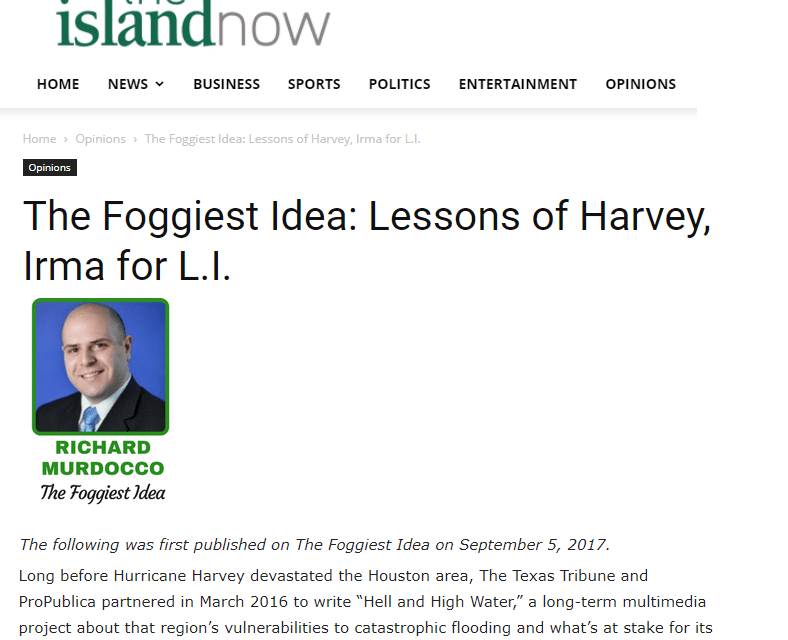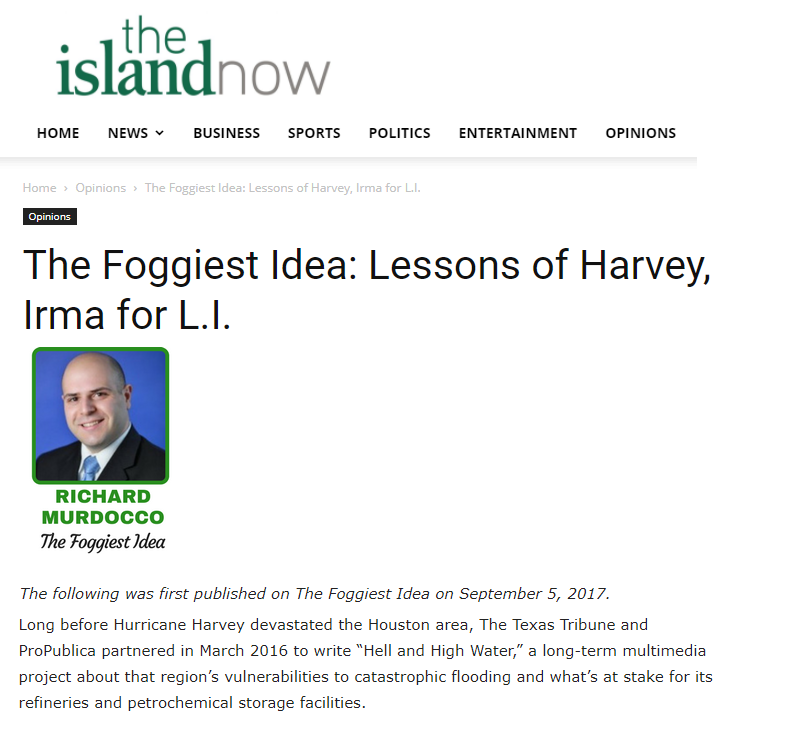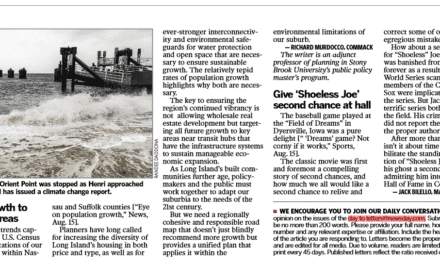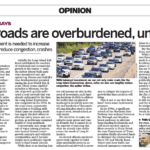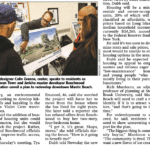The following was first published on The Foggiest Idea on September 5, 2017, and republished by The Island Now on September 14. You can read the piece here.
Long before Hurricane Harvey devastated the Houston area, The Texas Tribune and ProPublica partnered in March 2016 to write “Hell and High Water,” a long-term multimedia project about that region’s vulnerabilities to catastrophic flooding and what’s at stake for its refineries and petrochemical storage facilities.
The series was inspired by the widespread destruction of New Orleans after Hurricane Katrina despite years of warnings from scientists and journalists. This year the project won the prestigious Edward R. Murrow Award in the category of investigative reporting.
As Houston begins to emerge from the receding floodwaters and starts to survey the damage left behind in Harvey’s wake, the story’s words eerily echo like the unheeded prophecies of Cassandra.
“Scientists tell us that it is simply a matter of when, and not if, a monster storm is coming for Houston,” ProPublica’s Scott Klein wrote. “Like the rest of the Gulf Coast, the area is vulnerable to the kinds of strong storms that are becoming more frequent, and a major hurricane here could bring economic and ecological disaster.”
The fiery explosion at the Arkema chemical plant in Crosby, Texas, which lost even its backup generators so it couldn’t keep its volatile chemicals cold, just proves the point. The sharp rise in gas prices nationwide due to the shutdown of big oil brings it all home.
Long Islanders were warned decades ago about the risks posed by severe storms barreling in from the Atlantic.
In October 1984, the Long Island Regional Planning Board put it bluntly that “Long Island is highly vulnerable to the occurrence of a hurricane disaster of immense proportions,” adding that it had ample data in its Hurricane Damage Mitigation Plan for the South Shore to substantiate its ominous forecast.
Why did Nassau and Suffolk remain so vulnerable?
“Coastal areas on Long Island have experienced dramatic residential and commercial development and change in recent years,” the report explained. “As a result, the Island’s South Shore is far more vulnerable to storm-related damage and potential loss of life today.”
Our region should have learned from what happened in 1938 when the so-called Long Island Express slammed the East End. Estimated later to be a Category 3 (the Saffir-Simpson scale wasn’t created until the late ’60s), the hurricane brought lasting changes to Long Island’s geography. But since then, growth has only continued in the coastal floodplain, putting new generations at risk as we saw in 2012 when Superstorm Sandy roared in with its unwelcome wake-up call.
What the LIRPB had warned in 1984 was witnessed firsthand. With a powerful reminder of just how vulnerable Long Island is, municipalities have finally begun stepping up their storm readiness efforts. In the City of Long Beach, long-delayed projects to add protective dunes were given priority. Elsewhere state and local officials began to push for the elevation of residential units within the coastal floodplains. If that approach failed, they proposed buyouts of vulnerable parcels.
Efforts are also underway to restore much needed seagrasses, long known for their ability to mitigate erosion, and the recreation of long lost wetlands, which can help blunt the impacts of storm surge. Both were eliminated by the ills of over-development in the region’s fragile coastal zones, and prescribed to help ease the region’s storm vulnerability decades ago by planners.
The private sector is pitching in as well. In August, Newsday explored the many steps developers are taking to fortify their own waterfront projects to withstand a new normal created by climate change and rising sea levels. Some, reading the writing on the wall, are spending millions to go above and beyond local requirements for storm readiness.
Ever the pragmatists, though, they’re not exactly performing an act of charity.
“The last person you’re going to talk about being a tree-hugger is me,” Joe Graziose, senior vice president at RXR, told Newsday’s Maura McDermott. “This is all about infrastructure. At the end of the day, you want to build something that’s going to last a long time.”
It is sound planning to anticipate future super storms. Yet the larger issue is still unaddressed. Why do localities continue to let developers build in environmentally sensitive areas that could blunt a hurricane’s impacts?
When it comes to preventing acts of God like Sandy, Harvey, and Irma, government can do little in the short run. But natural disasters like them highlight the inherit dangers of ignoring long-term trends when crafting local policies regarding land use and development. Townships can directly influence the creation of sound coastal practices because these entities have the principal power of zoning.
A large-scale reclamation of wetlands, marshes and other natural barriers to storm surge should either replace coastal projects on Long Island, or become their anchoring feature—and townships should take the lead to make it happen with federal and state support.
Let’s hope that in handling Harvey’s awful aftermath the Federal Emergency Management Agency will not repeat how badly it botched its Katrina efforts and this time be able to help those most in need quickly and efficiently. On the legislative side, the response must be swift. New York’s congressional delegation has pointedly said that they won’t repeat the actions of Texas’s senators, now desperately seeking Washington’s assistance for their ailing constituents in the Lone Star State, who readily voted against providing Sandy aid to the stricken Northeast and delayed its passage for several months on Capitol Hill. This spirit of cooperation is a good start. Ideally it will inspire future actions of doing the right thing.
There is not much room for error. As Hurricane Irma, one of the most powerful storms in recorded history, threatens Puerto Rico and Florida mere days after the floodwaters in Houston began to recede, the stakes are becoming higher with each hurricane season. Years ago, New Orleans was hit. Then, it was Texas forced to bear the brunt of the storm. Next is Miami.
Here, it’s inevitable that Long Island will someday all too soon be slammed by another horrendous hurricane. For now, we must help our fellow Americans in Houston and south Florida rebuild and resume their normal lives. But we must also heed the lessons of this storm.
Collaboration of all levels of policymaking will be the key to our region’s survival. It is our only chance if we are to be adequately prepared when our own Harvey or Irma rumbles up the coast.
Richard Murdocco regularly writes and speaks on Long Island’s real estate development issues. He is the founder and publisher of The Foggiest Idea, an award-winning public resource for land use in the New York metro region. More of his views can be found on www.TheFoggiestIdea.org or follow him on Twitter @TheFoggiestIdea. You can email Murdocco at Rich@TheFoggiestIdea.org.
An Effective Way to Help Houston
The Texas Diaper Bank is in need of donations to provide emergency diaper kits to families being displaced by Hurricane Harvey. Your donations will help address a severe diaper shortage across the Houston region.
You can make a donation to the Texas Diaper Bank HERE.
You can find more ways to help those impacted by Harvey HERE.

